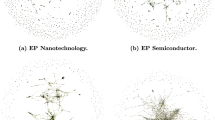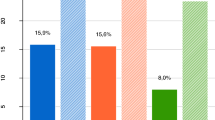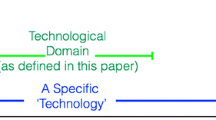Abstract
Attention has increasingly shifted towards the long-run perspective on technological innovation, which suggests that progress comes in waves, each one originating with a major breakthrough or general purpose technology (GPT). This paper seeks to assess whether nanotechnology is likely to be (or become) a GPT, a characteristic that other researchers have sometimes assumed though not necessarily documented. Based on a survey of existing literature, this paper will explore the extent to which nanotechnology addresses three primary characteristics of a GPT: pervasiveness, innovation spawning, and scope for improvement. The paper draws on patent and patent citation databases to highlight the types of quantitative and qualitative information that would be necessary, and in some instances is still lacking, to characterize fully the nature of nanotechnology.


Similar content being viewed by others
Notes
The disciplinary convergence hypothesis is not without its detractors (See for example, Khushf, 2004).
These plots are subject to substantial right-side truncation due to the data being collected from the granted patents—these figures do not include information available in the US since 2001 on published applications.
These scores (built from USPTO classes) for computer patents 1975–1979 were 0.63, 0.65, 0.66, 0.68, and 0.67, respectively, and are significantly higher than the scores for all patenting in those years (0.49 in each year).
Another problem for any such analysis would arise if the placement of citations by examiners was driven by some internal USPTO job incentive.
References
Aghion, P., & Howitt, P. (1992). A model of growth through creative destruction. Econometrica, 60(2), 323–351.
Alcacer, J., & Gittleman, M. (2006). Patent citations as a measure of knowledge flows: The influence of examiner citations. Review of Economics and Statistics, 88(4), 774–779.
Arnold, W. (1995). The SIA lithography roadmap. Microlithography World, Winter, 7–11.
Bresnahan, T. J., & Trajtenberg, M. (1995). General purpose technologies: ‘Engines of Growth’? NBER Working Paper No. 4148, Cambridge, MA: National Bureau of Economic Research.
Crichton, M. (2002). Prey. New York: HarperCollins.
David, P. (1990). The dynamo and the computer: An historical perspective on the modern productivity paradox. The American Economic Review, 80(2), 355–361.
Drexler, E. (1986). Engines of creation: The coming era of nanotechnology. New York: Anchor Books.
Graham, S. J. H. (2006). The determinants of patentees’ use of ‘continuation’ applications in the United States patent and trademark office, 1980–99. In Andersen (Ed.), Intellectual property rights: Innovation, governance and the institutional environment. Edward Elgar Publishers.
Graham, S. J. H., & Mowery, D. C. (2003). Intellectual property protection in the software industry, with David C. Mowery. In Wesley Cohen & Steven Merrill (Eds.), Patents in the knowledge-based economy: Proceedings of the science, technology and economic policy board. National Academies Press.
Hall, B. H., Jaffe, A. B., & Trajtenberg, M. (2001). The NBER patent citation data file: Lessons, insights and methodological tools. NBER Working Paper No. 8498. Cambridge, MA: National Bureau of Economic Research.
Hall, B., & Trajtenberg, M. (2004). Uncovering GPTS with patent data. NBER Working Paper No. 10901. Cambridge, MA: National Bureau of Economic Research.
Harriott, L. (2000). Limits of lithography. Working Paper, Bell Labs-Lucent Technologies.
Helpman, E., & Trajtenberg, M. (1994). A time to sow and a time to reap: Growth based on general purpose technologies. NBER Working Paper No. 4854. Cambridge, MA: National Bureau of Economic Research.
Huang, Z., Hsinchun, C., Yip, A., Ng, G., Guo, F., Chen, Z., & Roco, M. (2003). Longitudinal patent analysis for nanoscale science and engineering: Country, institution, and technology field. Journal of Nanoparticle Research, 5, 333–363.
Irwin, D. A., & Klenow, P. J. (1994). High tech R&D subsidies: Estimating the effects of sematech. NBER Working Paper No. 4974. Cambridge, MA: National Bureau of Economic Research.
Jovanovic, J., & Rousseau, P. (2005). General purpose technologies. Working Paper 11093. Cambridge, MA: National Bureau of Economic Research.
Kanellos, M. (2005). AMD’s 65 nano question solved: It’s a second half thing. CNET News.com, November 2, http://news.com.com/2061-10791_3-5929097.html?tag=nl.
Kanellos, M. (2006). Intel shows test chips made on future processes. CNET News.com, January 25, http://news.com.com/Intel+shows+test+chips+made+on+future+processes/2100-1006_3-6030489.html.
Khushf, G. (2004). A hierarchical architecture for nano-scale science and technology: Taking stock of the claims about science made by advocates of NBIC convergence. In Baird, D., Nordmann, A., & Schummer, J. (Eds.), Discovering the nanoscale (pp. 21–33). Amsterdam: IOS Press.
Kostoff, R., Stump, J., Johnson, D., Murday, J., Lau, C., & Tolles, W. (2006). The structure and infrastructure of global nanotechnology literature. Journal of Nanoparticle Research, 8(3–4), 301–321.
Lipsey, R. G., Bekar, C., & Carlaw, K. (1998). What requires explanation? In Helpman, E. (Ed.), General purpose technologies and economic growth (pp. 14–54). Cambridge: MIT Press.
Lux Research (2006). The nanotech report: 4th edition, volume 1. New York: Lux Research.
Meyer, M. (2006). What do we know about innovation in nanotechnology? Some propositions about an emerging field between hype and path-dependency. Paper presented at the 2006 Technology Transfer Society Conference, September 27–29, Atlanta, Georgia.
Moser, P., & Nicholas, T. (2004). Was electricity a general purpose technology? The American Economic Review, Papers and Proceedings, 94(2), 388–394.
Palmberg, C., & Nikulainen, T. (2006). Industrial renewal and growth through nanotechnology? Helsinki: ETLA, The Research Institute of the Finnish Economy.
Porter, A., Shapira, P., & Youtie, J. (2006). Refining search terms for nanotechnology. Briefing paper, prepared for presentation at national science foundation, first year review for the center for nanotechnology in society (CNS-ASU), Arizona State University, Tempe, AZ.
Roco, M. (2004). Nanoscale science and engineering: Unifying and transforming tools. AIChE Journal, 50(5), 890–897.
Roco, M. (2005). International perspective on government nanotechnology funding in 2005. Journal of Nanoparticle Research, 7(6), 707–712.
Roco, M., & Bainbridge, W. (Eds.) (2003). Converging technologies for improving human performance: Nanotechnology, biotechnology, information technology and cognitive science. Boston: Kluwer Academic Publishers.
Romer, P. (1990). Endogenous technical change. Journal of Political Economy, 98, 71–103.
Shea, C. (2005). Future management research directions in nanotechnology: A case study. Journal of Engineering and Technology Management, 22, 185–200.
Tannenbaum, R. (2005). Advances in materials and self-assembly. In Advanced Technology and the Future of Manufacturing, Proceedings. Atlanta, Georgia: Georgia Institute of Technology.
US National Science Foundation (2005). New grants are awarded to inform the public and explore the implications of nanotechnology, Press Release 05-179, http://www.nsf.gov/news/news_summ.jsp?cntn_id=104505&org=olpa&from=news.
Acknowledgements
Authors contributed equally to this work. This research was undertaken at Georgia Tech through the Center for Nanotechnology in Society (CNS-ASU), supported by the National Science Foundation under NSF NSEC CNS SES #0531194, in collaboration with research sponsored under NSF NSEC CNS SES #0531146. We gratefully acknowledge helpful comments we received from Philip Shapira and participants at the Technology Transfer Society Annual Conference, September 27, 2006, Atlanta, Georgia, USA.
Author information
Authors and Affiliations
Corresponding author
Rights and permissions
About this article
Cite this article
Youtie, J., Iacopetta, M. & Graham, S. Assessing the nature of nanotechnology: can we uncover an emerging general purpose technology?. J Technol Transfer 33, 315–329 (2008). https://doi.org/10.1007/s10961-007-9030-6
Received:
Accepted:
Published:
Issue Date:
DOI: https://doi.org/10.1007/s10961-007-9030-6




